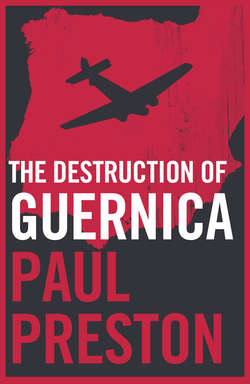The Destruction of Guernica

Реклама. ООО «ЛитРес», ИНН: 7719571260.
Оглавление
Paul Preston. The Destruction of Guernica
THE DESTRUCTION OF GUERNICA. REVISED EDITION. Paul Preston
Copyright
The Destruction of Guernica
Notes
Bibliography
About the Author
About the Publisher
Отрывок из книги
Cover
Title Page
.....
On 31 March, Mola arrived in Vitoria to put the final touches to the offensive that was to be launched on the following day. He began by deploying the weapon of mass fear which had been so effective for Franco in the advance on Madrid of the African columns. He issued a proclamation that was both broadcast and printed in a leaflet dropped on the main towns. It contained the following threat: ‘If your submission is not immediate, I will raze Vizcaya to the ground, beginning with the industries of war. I have ample means to do so.’16 In a similar spirit of crushing enemy morale, he ordered the execution of sixteen prisoners in Vitoria. The fact that among them were several popular local figures including the Alcalde, Teodoro González de Zárate, provoked protests from the local right.17 This act of gratuitous violence was followed by a massive four-day artillery and aircraft bombardment of eastern Vizcaya in which the small picturesque country town of Durango was destroyed by two bombing attacks carried out by four bombers and nine fighters of the Italian Aviazione Legionaria. Unlike Guernica, after the bombing, Durango remained under the jurisdiction of the Basque Government until 28 April. This permitted an investigation to identify the victims. As a result, the government published the figure of 258 civilians, 127 died during the bombing and at least a further 131 who died shortly after as a consequence of their wounds. Among the dead were fourteen nuns and two priests. Subsequent exhaustive research by Jon Irazabal Agirre reached the figure of 336 dead, of whom 276 could be identified and a further 60 who could not. As was later to be the case with the more notorious bombing of Guernica, Salamanca denied that the raid on Durango had taken place and attributed the damage to the Basques themselves.18
Rebel progress in the first three days of Mola’s campaign was so slow that Sperrle sent a report to Kindelán in which he complained that ‘if the troops do not advance faster, we will not enter Bilbao’. Sperrle believed that Franco had retained too much artillery and infantry on the Madrid front.19 On 2 April, Sperrle and Richthofen complained about this to Mola. Equally anxious to speed things up, Mola suggested to Sperrle that the industries of Bilbao be destroyed. When the German commander asked why it made any sense to destroy industries which it was hoped to capture shortly after, Mola replied: ‘Spain is totally dominated by the industrial centres of Bilbao and Barcelona. Under such a domination, Spain can never be cleaned up. Spain has got too many industries which only produce discontent’, adding that ‘if half of Spain’s factories were destroyed by German bombers, the subsequent reconstruction of Spain would be greatly facilitated’. In response to the notion that Spain’s health required the elimination of the industrial proletariat, Sperrle pointed out that the German air forces in Spain would attack factories only when Franco gave them specific orders to do so. According to Richthofen, Mola told Vigón to issue the order. Richthofen said that it had to come from a higher authority. Mola then signed orders himself for attacks on Basque industrial targets. Richthofen agreed to bomb the explosives factory at Galdácano on the ‘next free day’. Sperrle and Richthofen, however, informed Franco and awaited his permission to carry out Mola’s orders. Sperrle even offered to put an aircraft at Franco’s disposal for him to come to Vitoria to discuss the situation.20
.....